
Curse you, immortal BeeGee, for nominating me in the “7 Book in 7 Days,” challenge.
I typically don’t jump in such things unless it:
- is an incredible cause
- ain’t tryin’ to rassle’ money.
This fits both.
The rules to the “7 Books in 7 Days,” challenge as best as I know them so far.
BeeGee, am I getting this right?
- Suggest 1 book a day for 7 days
- Those 7 books should be the most influential books to you, assuming such things can be properly quantified
- With each book, nominate someone else to jump into the fray
- This isn’t a Facebook-alone challenge, as noted by how I was nominated via Twitter
Let’s begin.
1).Good Omens: The Nice and Accurate Prophecies of Agnes Nutter, Witch. Written by [Sir] Terry Pratchett & Neil Gaiman. Published 1990-05-01, ish.

About Good Omens:
The Apocalypse is scheduled to happen…now. Crowley, a demon tasked with his part in initiating the process, isn’t too keen on all that death and destruction interrupting his earthly pleasures. So, he decides to risk unimaginable punishment in order to subterfuge the oncoming Armageddon.
His first step is to recruit the angel Aziraphale, his all-but-and-only friend with whom he’s shared many adventures dating back to when the latter was a guard along Eden’s East Gate as the former tempted Eve with the apple.
Meanwhile, all eyes are on the birth and development of the anti-Christ, but a funny thing happened in the hospital nursery on the day little AC was born.
All was foretold by Agnes Nutter, witch, many generations ago, but no one reads anymore. Or, something like that.
Just as important: How did the Four Horsemen of the Apocalypse get four groupies?
And, remember: Leave a CD in your CD player for over 30 days, and it becomes Queen – Greatest Hits.
Why I read it.
It wasn’t too long after college when my cousin Cedan got me the book as a soft introduction into the world of Terry Pratchett. The late Sir Pratchett’s legendary Discworld series is ingrained upon my cousin’s psyche.
As for Good Omens, it took a couple of tries over the next couple months to get used into it, and a soft recalibration to the British humor – which is embarrassing for this semi-Anglophile to admit – but eventually Good Omens washed the taste of Kierkegaard out of my mouth.
By contrast, Cedan also gifted me the first two books in the Discworld series, The Colour of Magic & The Light Fantastic. It took me 20 years to finally read them because it took a quieter mind than what my demons allowed, or audiobooks and a chance to move around. Still not certain.
40 Discworld books to go.
What Good Omens means to me.
Aside from the Zahn trilogy (which should still be Star Wars canon) and Catcher in the Rye (I still don’t think Holden ended up in a funny farm), I didn’t read a book that didn’t feel like Saturday morning chores followed by a brussels sprouts lunch till I reached 21. Then, I found a slew of them. Unfortunately, barely a-one of them were in my Philosophy & Religion classes.
When I dove into Good Omens, I quickly got over my guilt of not having finished either the Kerouac or Kierkegaard bibliographies. I found a read that was both intelligent & delightful, and while dealing in the supernatural, didn’t burden me with the weight of eternal responsibility & repercussion.
In defense of my high school literature teachers, had I known how The Great Gatsby and The Grapes of Wrath ended, I might have been more inclined to endure the early prattle. Maybe.
Above all, the shit was funny as fuck. Once I dove in, the only reason Good Omens took so long to read the first time was because I kept bustin’ a gut.
I forgot books could be both tongue & cheek and poignant in the same line. Good Omens properly reminded me that snark & wit aren’t always found on the cutting room floor.
Good Omens was literary magic. How Pratchett & Gaiman’s synergism worked, I could only much-later poorly theorize:
I’ve only very recently read the first two Discworld books as well as conducted a deep-dive into Neil Gaiman’s novels collection along with Gaiman’s gold-standard Sandman comic book series. Before that, I couldn’t have imagined who did what, but now I think I can Lennon & McCartney who had the bigger influence in a passage. Times change and styles change, but if I had to guess, it would go like this:
- Pratchett, to me,
so far,spars with prose until both sides are dripped in sweat. Just when you think it borders on rough, he haymakers a crescendo. Literally abuses a gong with a sledgehammer to wake the story up. As I read his stories, I almost forget what it took to get me the point in the story, but everything stays innately ingrained. Incredible setups and reshaping of plots. So, like Lennon. - Gaiman is poignant, structured, and character-conscience, both in medium and entity. Each word he publishes could be bronzed. One can feel privileged to get to the next sentence. So, like McCartney.
By the way…
If ever you needed evidence that comic books can be art & literature, Neil Gaiman’s Sandman series would be the first place to seek documentation. I read them in the last year. Blew away every preconception I had about comics. Witty, intellectual, and honest. Read them.
Good Omens is coming to Prime Video. Heralded reviews. Bigger cast. Heart-melting back story.
The trailer alone has me salivating & singing Queen songs:
The cast includes David Tennant, Michael Stein, John Hamm, & Benedict Cumberbatch. Just, damn.
The backstory is perhaps the most amazing part.
Neil Gaiman made a promise to Sir Terry Pratchett that he would work to make Good Omens into a movie that they both would be proud of.
It read like a labor of Love. I’ll probably want to watch it as much as I read it.
And I’m in line to get the audiobook from the library, again, a week before the series gets to Prime.
Person nominated after book #1: Cedan.
Image Source: Amazon Prime Video via Twitter. The original image was Aziraphale-up.
2). Beatlebone, by Kevin Barry. Published CA October 2015
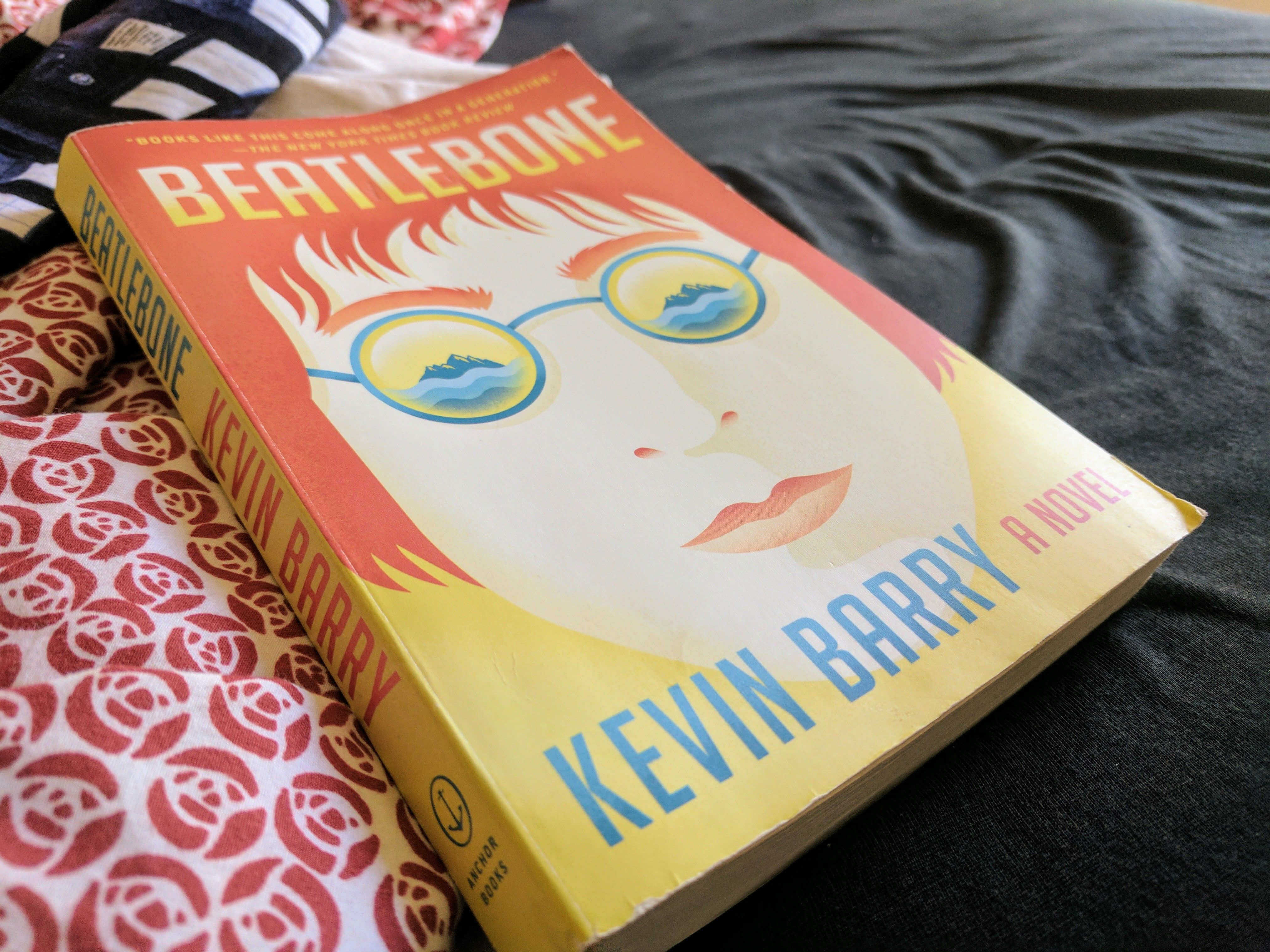
I gushed about Beatlebone when I finished reading it back in June of 2017. I went to the local bookstore in Pleasanton CA, and asked the clerk for prose that would blow my hair back. The clerk suggested this book. I was a little concerned about doing, “Beatles fiction,” but once I got going on it, I learned I had nothing to fear. The clerk was right.
What Beatlebone is about:
It’s 1978. John Lennon wants to escape New York in the dead of night and sneak out to his private island, Dorinish, along the west coast of Ireland, in order to conduct Primal Scream therapy. Except John Lennon can’t sneak down to the store for a pack of smokes without running into people who want something from him, let alone escapade to Ireland without heavy coordination if he wants to maintain his privacy.
Among the mysteries in the book is:
- Does John make it to his island?
- Does it matter?
- Did John really own an island on the Irish west coast?
The answers?
- You’ll find out.
- It stops being the point.
- Yes. He did.
What it meant to me:
Beatlebone’s prose is revolutionary. The book isn’t a page-turner, but only because I found myself studying the book as much as reading it when a particular passage kicked my ass. There were a lot of passages that kicked my ass.
Kevin Barry doesn’t give any adjective a break:
“There is a wardrobe full of old suits. It sits there like an accusation.”
Kevin Barry. Beatlebone.
And his attention to detail was layered with texture. I felt John in the book. It shocked the shit out of me.
I think I need to go re-read it, again.
Person nominated after book #2: Jackie Thomas. Writer & Co-Founder of Anglotopia.net
3). And Every Morning the Way Home Gets Longer and Longer, by Fredrik Backman. Published November 2016
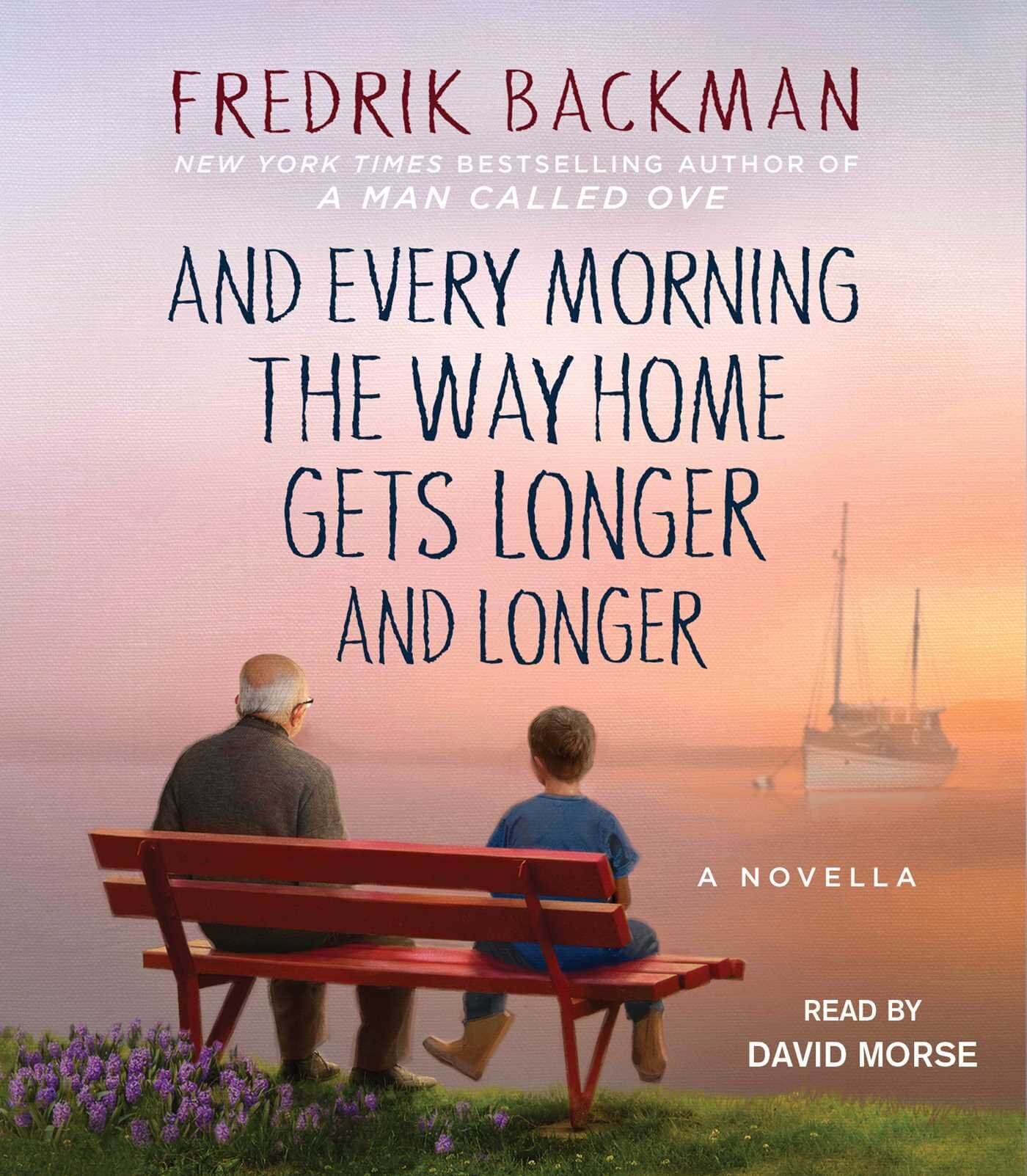
Katie loved Backman’s A Man Called Ove. I’ve read most of it. The movie filled in the gaps, subtitles and all.
Yes, I know, I need to not let the movie do that.
When I saw Backman’s novella show up on GoodReads, I was intrigued. The length and fluidity of the title alone quivered the side of my lip. “And Every Morning the Way Home Gets Longer and Longer.” It’s fluid and textured, probing yet rhythmic. And beautifully haunting.
I was hooked before I read a word within the covers.
I asked Katie about the book. She said she hadn’t read it. I just finished an audiobook. I thought I’d check it out for her.
UPDATE: Katie pointed out she’s the one who told me to read it. Probably true. It was a blur at the time. We were buying a house without an agent…
Source: Katie.
What And Every Morning the Way Home Gets Longer and Longer is about:
Grandpa is losing his memory. The family is losing their patriarch. Noah-Noah is losing his grandfather. Everyone’s trying to hold it together as the last remnants of Grandpa’s time slip away, both inside and out.
In the audiobook version I heard, Fredrik Backman discussed how he tried to go inside the mind of his grandfather (if I recall) in his attempt to understand how it feels when it all fades away.
In And Every Morning the Way Home Gets Longer and Longer, Grandpa jumps through memories and moments without rhyme, reason, or control. Generations and days are but one in the same. What would be an incredible stream of consciousness for anyone in good health is punctured with layers of agony, each more painful than the last, as Grandpa bats down his rising panic to hold onto the moments he holds most dear before they’re all but grains-of-sand brushed off by the next moment’s friction.
What it meant to me.
The book ripped me apart. I finished it while walking 101 in Garibaldi at night. Tears uncontrollably fell and ricocheted off my cheeks like a leaky drain spout in the Pacific wind. The ending fractured my emotional wall with each memory grandpa doesn’t remember he forgot, his agony compounded as he felt only the wake where the memory once resided.
I prayed for magic. I prayed for miracles. I prayed for unrealistic Hollywood endings, fighting inevitability with each step I took. Fighting for Grandpa. Fighting for equilibrium. Fighting for reciprocity. No quarter given. No compromises made until all that was left to pray for was peace.
And like that, it was over.
Grandpa reminded me of the OldOld Man, who’s nearing 94 and doesn’t remember as much as he used to, as most 94-year-olds would tend to do.
My fear is that one day it gets bad, and all the memories and moments he has left are lined up in a row for him to navigate. His mind, desperate to give him something plausible to go on, strips away the times and dates in order to best quilt the withered pieces back together.
But given his memory for sports, both recent and in the past, if ever such a nightmare were to appear, it wouldn’t be for at least a few more baseball seasons.
Hat tipped to you, Mr. Backman.
Person nominated after book #3: Mrs. Katie Finn.
4). Fear and Trembling by Søren Kierkegaard. Published in 1843 under the pseudonym Johannes de silentio.
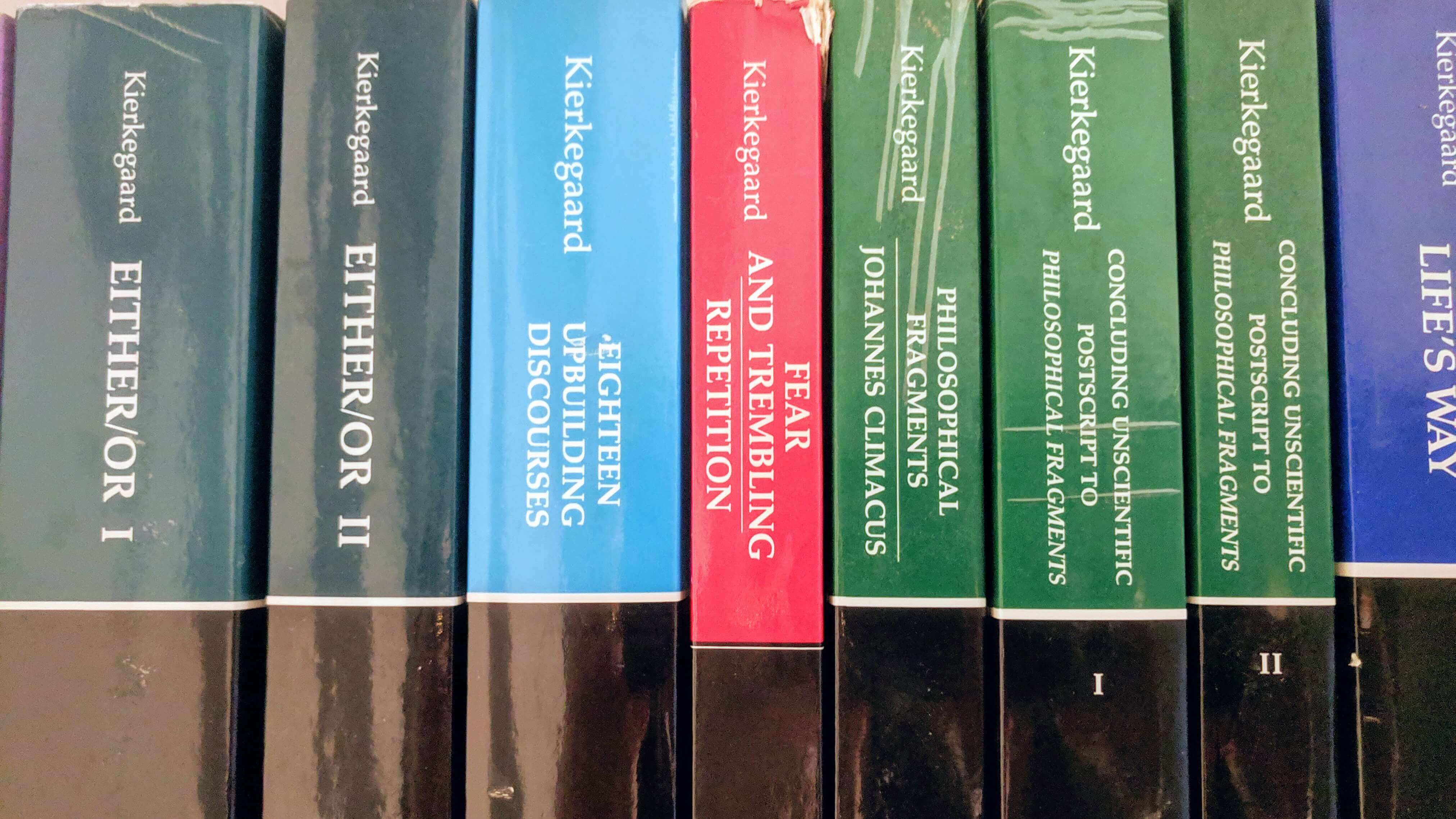
One didn’t make it through our Philosophy & Religion classes without an inordinate helping of Søren Kierkegaard.
To me, it was sometimes difficult to deal with him because if you weren’t slicing through his bravado, you were marsh-stomping through his self-loathing. And though he was a sickly child, he really didn’t have problems. I’d have classmates oodling over his latest unearthed noogat and I’d be like:
“That you had a high school relationship makes you more qualified to undestand the pain and anguish of love & rejection than Søren Kierkegaard.”
Me. Aged 21.
The true father of Existentialism. An original pioneer in Post-Moderism, back twenty minutes ago when it was a philosophy and not a fashion choice. Or some shit.
I didn’t get Fear and Trembling in class because our coveted professor wasn’t teaching Intro to Philosophy when I had to take it. Instead, I had to take it with the teacher we tried to avoid by switching into the Philosophy & Religion concentration. It was okay here because the dear scrambled prof was on our turf. I think he knew it, too, because our Intro to Philosophy books were fill-in-the-blank Plato, Aristotle, and Descartes primers.
Welcome to college.
And, back to the point…
It was a couple years after my first undergrad when I decided to mire through the entire Kierkegaard collection while working nights at the boat.
It was a complimentary routine:
- Read 3 pages – Which in Kierkegaardom could take 30 minutes
- Get a pickup
- Run & drive around the property while thinking about what the Hell those pages were about
- Go back in, grab my stryofoam cup of diet Pepsi
- Re-read the 3rd page
- Trek onto the next two
- Get a pickup…
I got through his Early Polemical Writings (Hong translation), Concept of Anxiety, the companion biography we had to get back at Denom U, a heavy volume of his journals and “short” writings, and eventually parts of Either / Or before it got too dense to try and read in 20 minute spurts. So, I started looking for something lighter.
Everywhere I went:
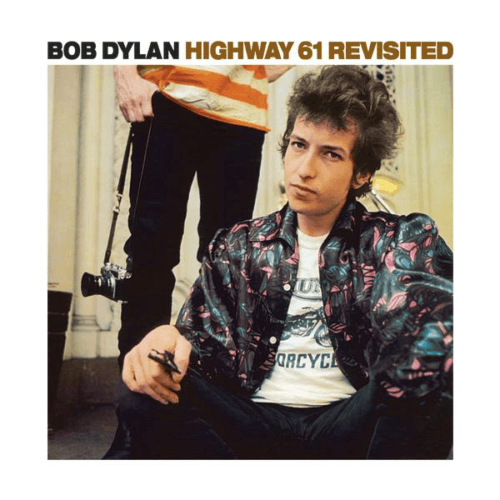
Fear and Trembling is sitting on the coffee table in the beginning of Salinger’s Franny & Zooey. I remember sitting at our duplex in Lafayette reading Franny & Zooey, staring down at our thrift store coffee table, going so far as to lift my crossed legs to look underneath and make sure Fear & Trembling wasn’t sitting on every coffee table everywhere, once you’re ready to see it.
At the time, Dylan’s Highway 61 Revisited was a fixture in my car’s 10-disc changer. I don’t know whether or not things are called to folks or if simple patterns emerge or if they’re all just semantical cousins, but I kept coming across pieces discussing Kierkegaard’s influence in Dylan’s work, especially in Highway 61 Revisited, the song.
Enough was enough. I was ready to dance with Søren’s most popular work.
What Fear and Trembling is about:
In Fear and Trembling, Søren Kierkegaard takes on one of the most controversial stories in the bible.
Which one?
Genesis 22.
What’s Genesis 22 about?
Well, let’s let Bob tell us:
Oh, God said to Abraham, “Kill me a son”
Highway 61 Revisited. Written by Bob Dylan.
Abe said, “Man, you must be puttin’ me on”
God said, “No” Abe say, “What?”
God say, “You can do what you want, Abe, but
The next time you see me comin’, you better run”
Well, Abe said, “Where d’you want this killin’ done?”
God said, “Out on Highway 61”
I swear if Søren Kierkegaard could selfie in his books, he would. I was expecting more grandstanding when I jumped into Fear and Trembling, but I couldn’t have more wrong. Whether it was the loss of his fiancée…
– don’t even get me started on that –
…or his bloodlust of taking philosophical swipes at G.W.F Hegel, Kiekegaard no-bullshit attacked the story of the sacrifice of Abraham. He takes 3, 4 swipes at the story, each one deeper and more thorough than the previous one.
- Swipe one. Aesthetic: The superficical. Not unlike impulse counter magazine readers.
- Swipe two. Ehtical: Whatever is right because you saw it in the TV adapation of a book your guardian or superior once told you to read.
- Swipe three. Religious: Choice, in its purest form. Out on the ledge. No hands to hold. Piss in the wind or let it blow you away, or think. (Hint, you can piss later).
Or something to that effect. It’s been 20 years.
It was like verses in a blues song, picking up steam with each pass.
I almost called off work the next day in order to read it in one sitting. I finally got what our coveted professor saw in Kierkegaaard.
What it means to me:
Simply put, the book reminded me I can piss later. Choices, choices, choices, and don’t let any more-heralded fuck tell you otherwise, even if it’s God. Because, if nothing else, when you aren’t you, you’re not good to anyone.
Person nominated after book #4. Dear Julius, because he deserves a mindfuck.
5). The Art of War by Sun Tzu. Published 5th Century (ish) B.C.
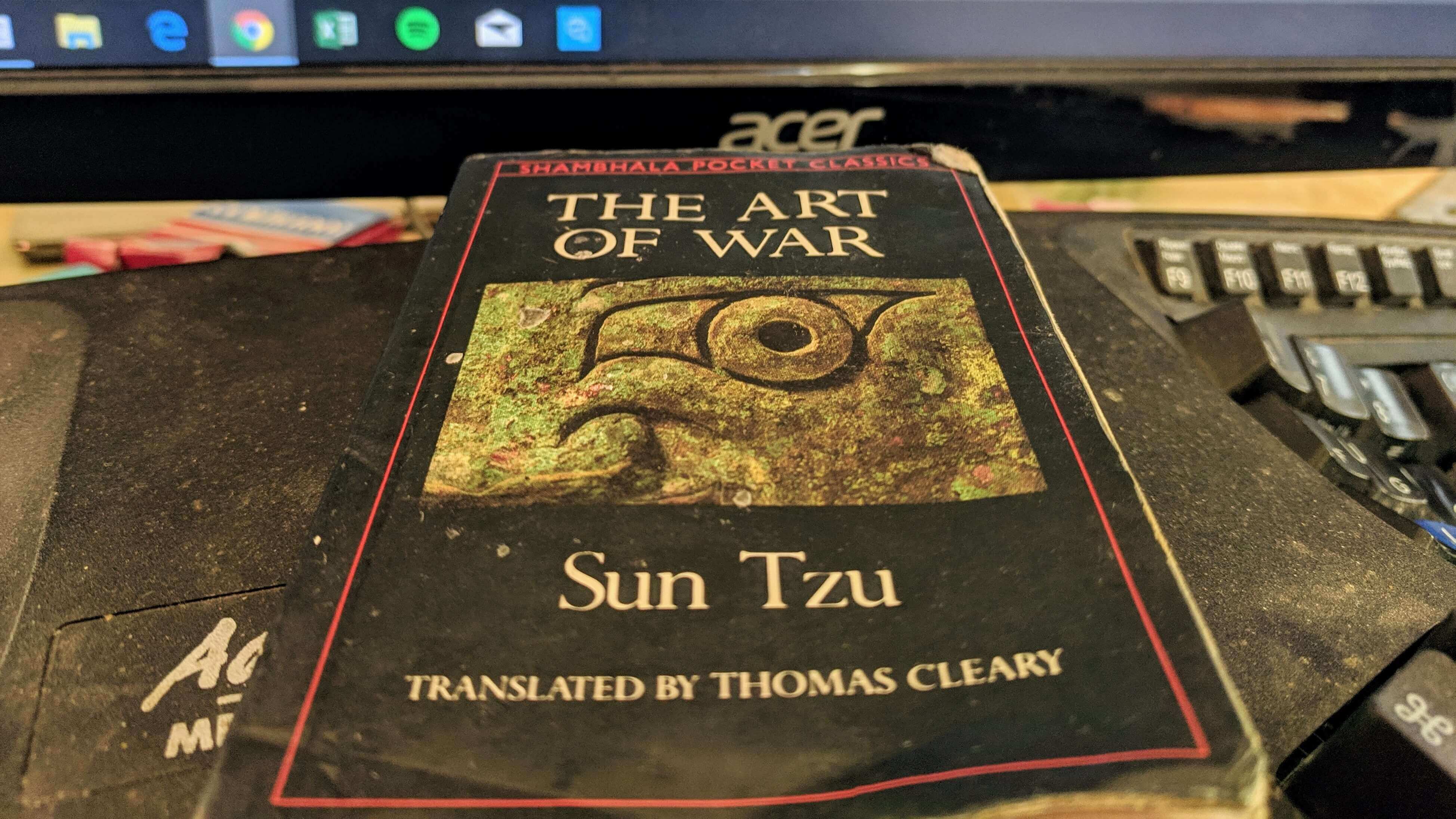
If you’ve read a business book or a strategy book or a life change book or a self-help book or prenatal cooking book or fad diet alternative book or a CGI-fest action movie, you’ve seen & read the essence of The Art of War in one fashion or another. Along with Tao Te Ching, The Art of War is possibly the most over-quoted and stolen work this side of the Holy Bible. A good chunk of the reason is because those works are in the public domain. The other big chunk of the reason is because The Art of War is damned good.
What The Art of War is about:
Let’s start with the writer:
The common belief is that The Art of War is the written summation of the principles of the Chinese military general Sun Tzu – “Master Sun.” Anymore there are varying degrees of thoughts regarding which specific general wrote them. There are other thoughts believing it to be a collection of wisdom from Chinese generals (plural).
Whoever the Hell wrote it, the principles are tried, true, tested, repeated, profited from, and passed on to the next generation.
And, whoever said writer(s) was (were), history claims the general was a holy-shit badass. There’s a story in the copy I keep in our library about how Sun Tzu taught the principles to a King’s concubines as a demonstration. When the king’s favored concubines didn’t take it seriously, Sun Tzu made a sacrificial example of them.
More specifically:
The book goes into plans, preparation, tactics, and execution when going to war. Sun Tzu shows strict care for resources, troops, and the bigger picture with respect to the moment. Specifically, considering the war with respect the battle, and vice versa.
Biggest takeaways include:
1). A measurement of a commander is how easily they can win:
“The supreme art of war is to subdue the enemy without fighting.”
Sun Tzu [translations vary]
2). Sun Tzu was about the high ground before Obi-Wan Kenobi made it cool.
Always be mindful of these factors:
- The Way: The method. The strategy. Efficiency. Care.
- Seasons: If you’re ever in Hell, ask Napoleon about the Russian Winter.
- Terrain: “...never get involved in a land war in Asia…” – The Princess Bride
- Leadership: Why most of those offshoot books are written
- Management: The other reason why most of those offshoot books are written
3). Misdirection and deception are cornerstones.
“All warfare is based on deception.”
Sun Tzu [translations vary]
4). If you know thyself and know thy enemy, you can be confident in the aggregate outcome.
It’s one of the many reasons why I love how Basketball, Baseball, and Ice Hockey use a best-of-7 games to determine champions.
5). The book itself is a measurement of efficiency.
Small enough in structure to fit in my backpack zipper pocket. Big enough in praxis to be taught by world leaders, generation after generation.
What The Art of War means to me:
I read the book once a year or so. Oftentimes, I’ll read it on a plane when I’m out of things to pass the time. It’s a creed. The mantras and life lessons are more than noteworthy.
I don’t know when I started carrying it around with me everywhere. It’s been since shortly after Churchin’ School days. In fact, when I was in my Business Strategy class, the capstone prof spent a good share of a lecture on the book. He asked if anyone heard about it. I pulled it out of my backpack to show. He nodded, and I spent the rest of the class time that semester on the enjoying the fresh aire on the loading docks with the Dean of the Business department, chatting up life and world business movements with him and the head of IT while they smoked. So shit goes.
I lost out on a starting slot on my 8th Grade basketball A team because I wasn’t aggressive enough. I was relegated to the B team for most of the year, I’m guessing to, “find my mojo.” I spent a lot of my academic career that way. I only seem to let myself be myself when I think no one back home is looking. Reading books like The Art of War reminds me I have as much a right to plant my feet on the pitch as does anyone else. It’s a chronic reminder, a labor Katie tirelessly takes up with me.
Person nominated after book #5: Cousin Doug. Seriously, I can’t give one to Julius and NOT give one to Doug. There’s a law out here in Tillamook about that, I’m certain.
6). Caro’s Book of Poker Tells by Mike Caro. Published March 2003.
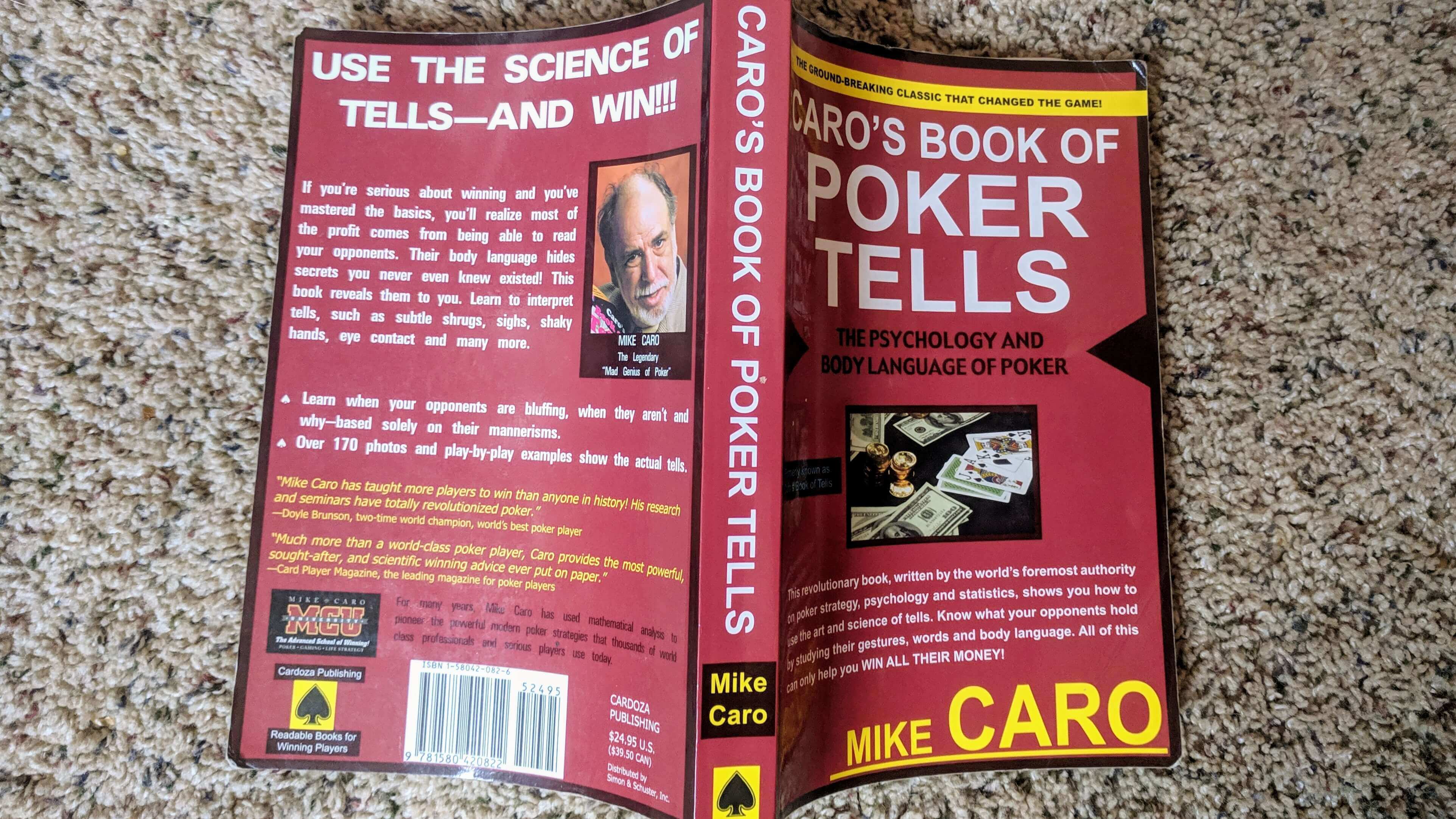
I hemmed & hawed about what to put into the 6th slot of the “7 books in 7 days” challenge. It was between this and Player Piano by Kurt Vonnegut. In the end, the challenge is about books that are influential to me. While Kurt might be inspirational to me, and not putting a Vonnegut book here meant not having a Vonnegut book on my list (for I have a 7th book in mind), Caro’s’ Book of Poker Tells helped me more with decision-making & character development than any of Kurt’s best, including Player Piano.
Why Caro’s Book of Poker Tells won out.
All the self-help, business guru, and religious books combined wouldn’t give you as much proper insight into the factors, situations, and motivations that go into decision-making as does Caro’s Book of Poker Tells. Sure, it’s a poker book. A top-10 poker book, typically. I don’t think it was intended for general self-help, but oftentimes the greatest breakthroughs happen while the focus was elsewhere. Less pressure that way, probably.
Caro breaks down tells & player actions into a series of references including:
- is the player acting?
- is the player any good at what they’re doing?
- what are the benefits, outcomes, and expectations of the situation?
- how is it changing over time?
And, of course, commit this to memory. It’ll help you one day:
“Players are either acting or they aren’t. If they are acting, then decided what they want you to do and disappoint them.”
Mike Caro’s Great Law of Tells
Then Caro goes into what to look for. Like The Art of War, the lessons cross-apply over a bevy of life situations spanning outside the initial premise.
How Caro’s book of Poker Tells helped me.
Me and the neighborhood boys would play in the local bar league. It’d get me out of the house when I was between drafts. The book helped me, along with practice and repetition, discern who was solid, who was weak, who was conservative, who was loose, who was calculating, and who was gambling. Over time, I got to notice when people would change it up, when an actor wasn’t acting, when a tight player was trying to be unpredictable – and how good they were at the switch.
I got good enough to the point where I could psych out a weaker opponent by betting without looking at my hand. Sure, it’s seldom an advised strategy, but when you’re in big blind and the player in the dealer’s spot is trying to steal your blind & you think you can determine he’s bluffing? Pushing back over the top is often a power play to show you won’t get pushed off your forced ante without a fight. When they realized you just pushed over the top without looking at your cards, and they know their cards suck? It’s an “I read you like a book” psych-out that can last for many, many hands. Besides, you can’t give away a tell if you have no idea what your cards are.
It also helps to know poker before you read the book. This isn’t a poker tutorial book.
What the book did for my character development:
The book isn’t about bravado and showdowns. It’s about you being both completely self-aware and aware of the Russia doll of situations you’re in while being receptive to all the available information around you. It’s about determining who’s aware, who’s oblivious, who’s full of shit, who does & doesn’t think about the long game, and who’s never going to get any better, all the while reminding yourself the need to continue to push yourself to strive, grow, and profit from the experience by both intrinsic and extrinsic means.
One situation at a time.
I try to look at my characters this way. What’s great is when I look at them through these labyrinth of beneficial filters and, through everything I know, one trips the system and surprises me. It’s like I set myself up for their amazement. No, I take that back. I think that when their surprise growth happens, they become the contradiction that proves the system. Creation in action.
PS: Here’s a sample of Mike Caro with Doyle Brunson.
And all those other things they never taught me at Churchin’ School.
Person nominated after book #6: the Nappa himself.
I’ve been waiting to Bum around on the final book.
7). The Dharma Bums by Jack Kerouac. First published in 1958.
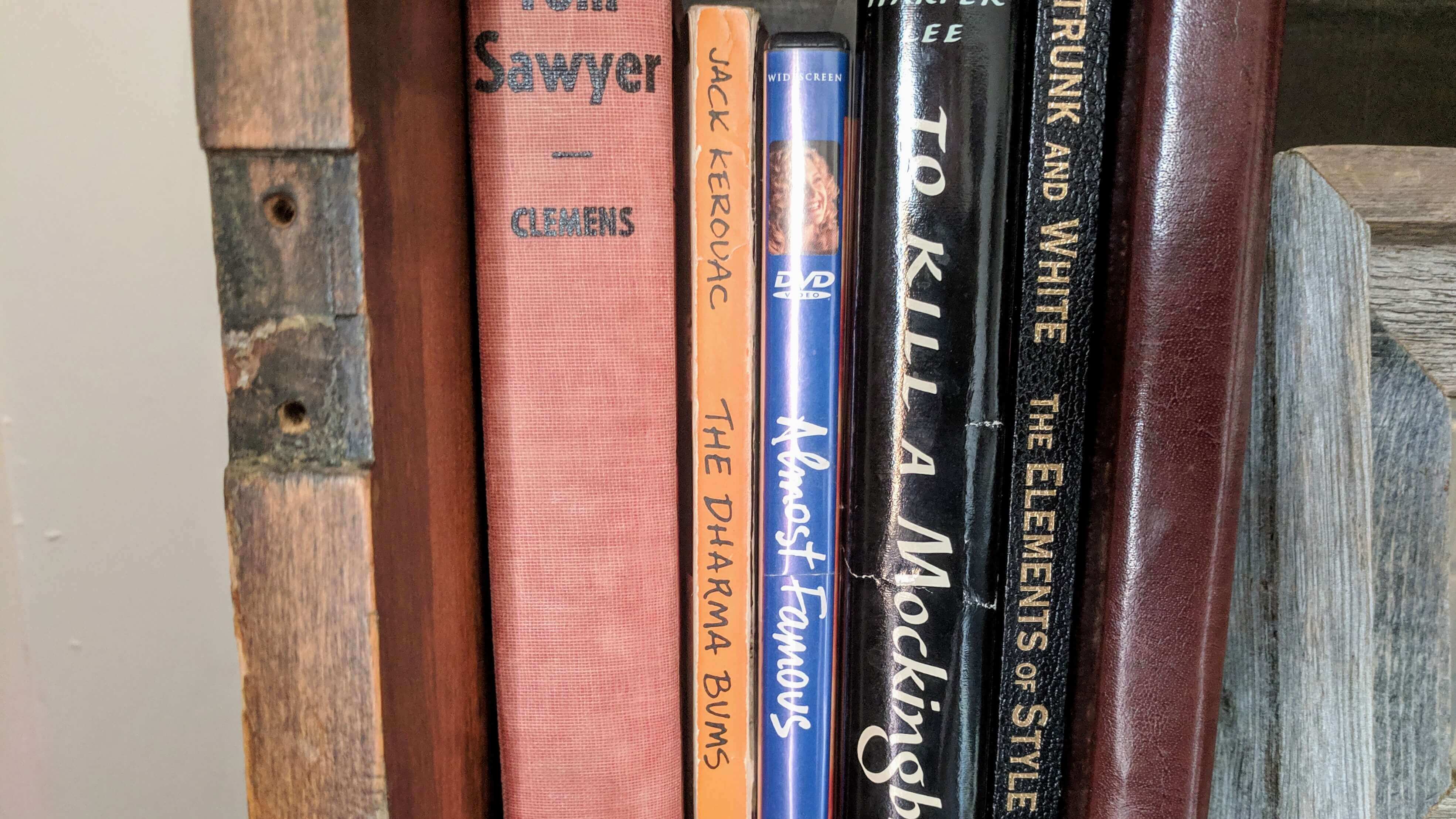
To me, my 7th book of the 7 books in 7 days challenge is the book. The Dharma Bums started everything in motion.
As for how, it started with the vivacious, mercurial classmate I later used to inspire Søren, Danish ø and all, in them Books of Blues. Here are a couple signature stories about him:
- The time we studied a truck driver at a hotel in Alamogordo, NM
- The time I skipped Daytona Beach spring break with a bunch of hot-ass lady classmates just to later stand on the Sierra in Alamogordo, NM and embrace a peaceful Zen
And, now, here’s this one:
The time Søren gave me my copy of The Dharma Bums, and changed my life.
It happened on some sleepy Tuesday or Thursday early-Spring late-afternoon when sundown screams final words of encouragement through mother nature’s languishing hold on hibernation. Modern Philosophy was done for the day but the carb-loaded cafeteria wasn’t yet open for dinner. A few of us hid from the slushy, muddy snow-melt creeks draining throughout the campus grade by retreating to our cinder block cell dorms.
Our caravan stopped at Søren’s cell dorm. He and his roommate had a nice library of books stacked on their plastic crate & common pine board shelves.
Søren talked about jazz. Pure jazz. The improvisation-of-life-in-motion jazz. That jazz. It was the first time I heard him talk about the topic. All he was missing was the pipe he wasn’t allowed to have on campus and his tweed jacket, probably molting in his cubed closet.
As he lectured, my thoughts were inspirationally steered towards his library. His collection included a lot of classic works and anthologies, all with well-worn bindings.
That book stood out. I must have studied it awhile because he broke my concentration.
“It’s yours,” said Søren.
“What is?”
“The Dharma Bums. Read it. It’s yours,”
“Oh, no,” I said. “I was just wondering what it was.”
“It’s jazz,” said Søren. “Weren’t you listening?”
He would have delightfully chewed on that pipe…now.
“I don’t see On the Road,” I said. “I was wondering why the only Kerouac you had wasn’t On The Road.”
Note: Conversations are estimated.
He started with his infectious, light-up-the-room-and-make-everyone-feel-included smile.
“On the Road is good. The Dharma Bums is jazz. It’s my second favorite book, ever.”
“And your favorite?” I asked.
“The Moviegoer,” said Søren.
He would have finished by taking another puff on his pipe – wait a second…one more…here. He settled for that smile, which alone radiated tangible, illuminating excitement into every crevice of the room. That fuckin’ smile, toothy and bubbly, Cheshire yet comforting, irritating yet cosmic, illustrative as if from classic comics. That fuckin’ smile alone gave us an extra few minutes of sundown.
“I love Walker Percy.”
I looked to his roommate. We nodded in comprehensive unison.
“Start with The Dharma Bums. Consider it your introduction.”
I panned back to the book, then back to Søren ‘s face. He wasn’t selling the idea of me reading the book. He was inspired by it. He was about to burst into a Broadway number about it – all because he didn’t have that pipe handy.
“Go on. Take it,” said Søren.
I looked to his roommate, who nonchalantly nodded to me as if this was normal to him. I looked back to Søren, who, to me, looked like a pastor greeting me into the congregation.
I pawed at the binding, hoping it would simply fall into my hands so it didn’t feel like I was taking it from him. Shit fellow poor kids would understand.
“You’re on your way,” he said, assuring me, once again, everything was going to be incredible.
Fuckin’ incredible.
I didn’t read it till the weekend. I didn’t read it again till Summer break. I Never forgot about it.
To loop my blog stories together, I treasured his influence so much that the following season, when he followed his parents out to New Mexico and finished his senior season at a nearby state school, I skipped Spring Break in Daytona Beach to see him in New Mexico, and nothing was ever the same.
It’s harder to try and read it now. I used to relate more to its beginning. Now I relate more to its ending. It probably has to do with having lived in Bay Area for a 4-year hiccup, and missing it more now than when we were there. Must be a stages thing.
Person nominated after book #7: William Hill. He and his wife moved to Bay Area before us, still live there after us, and have still never been to The Big Sur. That needs to change.
And, no, William, you don’t need to read Kerouac’s The Big Sur before you go. It won’t help. The Dharma Bums, on the other hand, will.
I guess I should recap this next.




Leave a Reply
You must be logged in to post a comment.